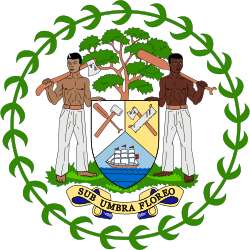| Coat of arms of Belize | |
|---|---|
 | |
| Armiger | Belize |
| Adopted | 1981 (standardised in 2019) |
The coat of arms of Belize was adopted upon independence in 1981. It differs only slightly different from the arms used when Belize was a British colony (the Union Jack has been removed, and a Mestizo has replaced one of the Afro-Belizean woodcutters supporting the shield). [1] [2]
The wreath around the arms is formed of 50 leaves, symbolising the year 1950, "when Belizeans began the struggle for independence". [1] Within the wreath is a mahogany tree, in front of which is a shield split per chevron and per pale. The upper sections of the shield show the tools of a woodcutter, while the lower section shows a ship under sail. These are symbolic of the importance of mahogany in the 18th- and 19th-century Belizean economy. [3] The motto is Sub umbra floreo ("Under the shade I flourish"), a reference to the country's forests and to its establishment as a colony under British protection. [1]
The flag of Belize features the coat of arms in its centre.



